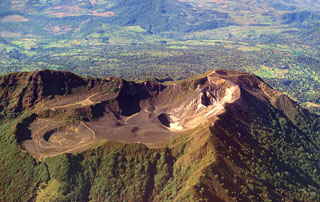Report on Turrialba (Costa Rica) — 5 September-11 September 2007
Smithsonian Institution / US Geological Survey
Weekly Volcanic Activity Report, 5 September-11 September 2007
Managing Editor: Sally Sennert.
Please cite this report as:
Global Volcanism Program, 2007. Report on Turrialba (Costa Rica) (Sennert, S, ed.). Weekly Volcanic Activity Report, 5 September-11 September 2007. Smithsonian Institution and US Geological Survey.
Turrialba
Costa Rica
10.025°N, 83.767°W; summit elev. 3340 m
All times are local (unless otherwise noted)
OVSICORI-UNA reported that fumarolic activity and gas discharge in and to the W of Turrialba's central crater continued throughout August. New points of gas discharge, small landslides, and accelerated vegetation die-off were noted from various locations within and around the crater. Fumaroles were active in almost all directions in the central crater; many exhibited sulfur deposits and those in the S, SE, and SW reached a temperature of 91 degrees C. Fumaroles at the bottom of the W crater reached 176 degrees C on 16 August. Small sulfur flows from a few of the fumaroles descended about 2 m from the emission point. Steam plumes from fumaroles on the W wall rose to an altitude of 3.8 km (12,500 ft) a.s.l.
New fumaroles appeared on the SW flank and N and NW of the central crater. Some of the fumaroles corresponded to two widening cracks, to the SW and NW of the W crater. Vegetation affected from gas and steam discharge and sulfur deposits were noted. People living on the N flank and from areas to the NW and W reported constant gas emissions from cracks in an area of about 20 by 50 meters, NW of the W crater.
Geological Summary. Turrialba, the easternmost of Costa Rica's Holocene volcanoes, is a large vegetated basaltic-to-dacitic stratovolcano located across a broad saddle NE of Irazú volcano overlooking the city of Cartago. The massive edifice covers an area of 500 km2. Three well-defined craters occur at the upper SW end of a broad 800 x 2200 m summit depression that is breached to the NE. Most activity originated from the summit vent complex, but two pyroclastic cones are located on the SW flank. Five major explosive eruptions have occurred during the past 3500 years. A series of explosive eruptions during the 19th century were sometimes accompanied by pyroclastic flows. Fumarolic activity continues at the central and SW summit craters.
Source: Observatorio Vulcanologico y Sismologico de Costa Rica-Universidad Nacional (OVSICORI-UNA)

